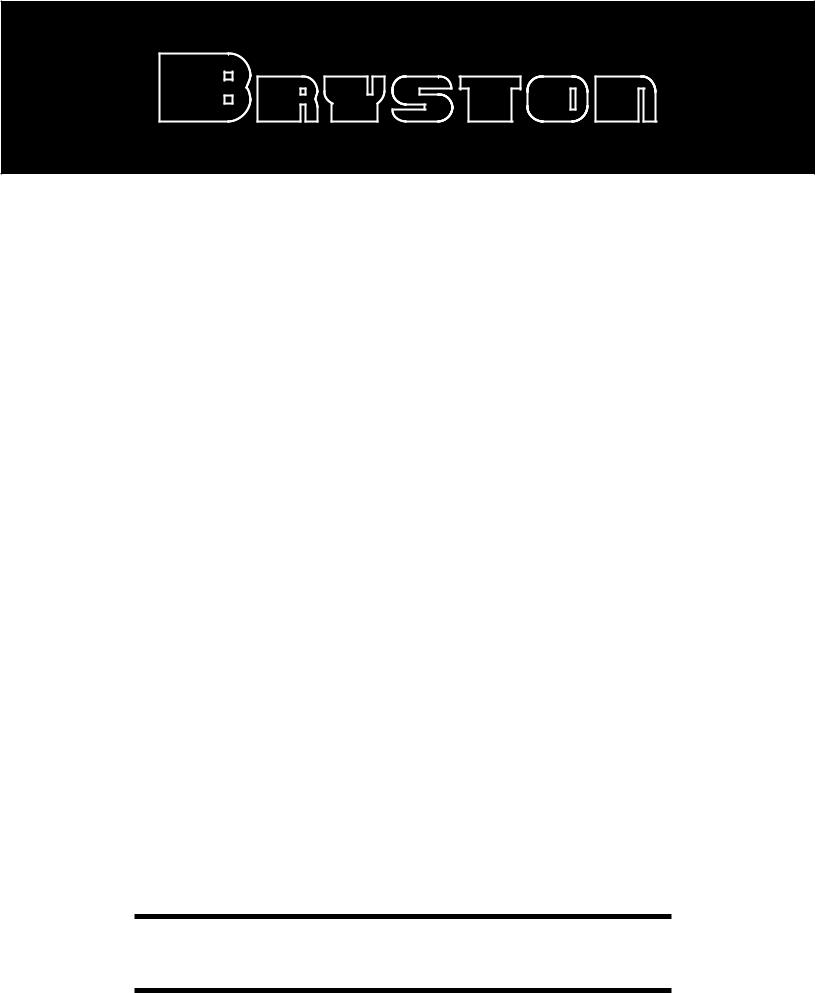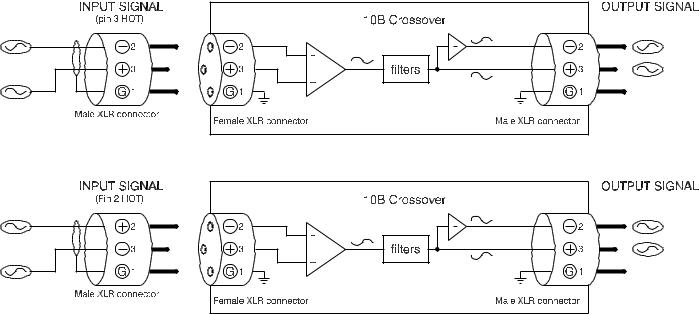Bryston 10B-SUB, 10B-STD, 10B LR User Manual

10B
CROSSOVER
OWNER’S MANUAL
for Models 10B-STD, 10B-SUB & 10B-LR
INTRODUCTION:
The 10B crossover is available in three stock versions; 10B-SUB incorporating frequencies more suitable to sub-woofer applications (40Hz to 500hz), 10B-STD which is more applicable to speakers requiring frequency control in the mid-band and tweeter areas (70Hz to 4500Hz) and the 10B-LR, which uses plug in resistor programming cards to set the crossover frequency. Both the 10B-SUB and 10B-STD crossovers include a mode called Mono Low Pass (see below) which replaces the Two Way Mono (Linkwitz-Riley) mode in older model 10B’s. The Two Way Mono mode (see below) is retained in the 10B-LR allowing for very steep (non Linkwitz-Riley) 8th order filters.
MONO LOW PASS mode (10B-SUB and 10B-STD only):
The 10B-STD and 10B-SUB crossovers generate a summed low pass output signal by first summing or adding together the left channel and right channel input signals to form a left plus right (L+R) signal. If the MODE switch (located on the rear panel) is in the Mono Low Pass position then this L+R signal is fed into both of the low pass filter sections (Left and Right) available in the 10B. As a result, the common low pass output can be taken from either of the two low pass (LP) outputs; either left LP out or right LP out. These outputs are designated as Left and Right for convenience only. If the low pass output used is the one designated as the left channel, then the crossover frequency and slope
(or filter order) switches on the left side of the unit’s front panel (as viewed from the front) will control the low pass filter parameters. Likewise, if the right channel low pass output is used, then the right channel switches will control its filter parameters. There is no interaction between the two sets of controls. If one of the two low pass filters is not used, then settings of its crossover frequency and slope switches are irrelevant and will have no affect on the performance of the other filter sections of the crossover. The two high pass filter sections (left and right) operate independently in Mono low Pass mode.
STEREO mode:
As in the older versions of the 10B, the stereo mode provides two, two way crossovers wherein the left input is fed into a separate low pass filter and a separate high pass filter, both of which are independently adjustable from the front panel controls. Likewise, the right input signal is fed into a separate low pass filter and a separate high pass filter, both of which are independently adjustable from the front panel controls. All four filters have separate output connectors on the rear panel. There is no interaction whatsoever between left and right channels or between low pass and high pass filters.
THREE WAY MONO mode (10B-LR only) :
Available only in the 10B-LR (Linkwitz-Riley filters), this mode is the same as in the older model 10B. The four filter sections (two low pass and two high pass) of the 10B are combined to form a single channel three way crossover providing one low pass, one mid or band pass and one high pass filter. The mid (or band pass) filter is formed by combining the left channel high pass and the right channel low pass filters into a single filter wherein the lower end of the pass band is determined by the left channel high pass controls and the upper end of the pass band is determined by the right channel low pass controls
Only the LEFT channel input is used in Three Way Mono mode. The left channel low pass output provides the low pass output. The mid or band pass output is taken from the right channel low pass output connector and the high pass is taken from the right channel high pass connector. All filter slopes are 24dB per octave, Linkwitz-Riley alignment.
PROGRAMMING the 10B-LR crossover:
The crossover points in the 10B-LR are set by inserting small programming boards (4 per channel) each containing 2 resistors. See illustration “10B LINKWITZ-RILEY STEREO CROSSOVER” and on page 7 and document “10B-FREQ-RES-TABLES.doc”
POWER AMPLIFIERS:
When power amplifiers of different power capabilities are used, the woofers will likely be driven by the most powerful amplifier and the tweeters by the least powerful amplifier since the woofers can generally be expected to be less efficient. When power amplifiers of equivalent power capabilities are used in a bi-amped system, and when the power amps employ totally separate power supplies for each channel (as all Bryston power amplifiers do) it is desirable to place each power amplifier as close to its speaker as possible and use one channel to drive the woofer and the other to drive the tweeter. Please note that if the power amps being used do not employ totally separate power supplies for each channel, some envelope distortion between channels may occur since the power drawn from the low frequency channel driving the woofer will usually be considerably greater than from the higher frequency channel driving the tweeter.
POWER AMPLIFIER PLACEMENT:
Where there is a considerable distance between the audio signal source and the speakers, it is preferable to reduce the distance between the power amplifiers and the speakers at the expense of increasing the distance between preamp and crossover or crossover and power amplifier. The low impedance across the speaker lines is more likely to affect signal quality with distance than is the higher impedance across the preamp to crossover, or crossover to power amplifier cables.
BALANCED versus UNBALANCED CABLING:
If the distance between the power amplifier and crossover or crossover and preamplifier is greater than 30 feet, it may be desirable to use balanced cables to interconnect the two distant pieces of equipment as this may reduce noise pickup. To facilitate this, the 10B crossover is available with balanced inputs and outputs (PRO versions) using 3 pin XLR connectors (outputs use male connectors, inputs use female connectors). Pin 3 is the positive (non-inverted or Hot) signal, pin 2 is the negative (inverted or neutral) signal and pin 1 is ground.
Where a long run of balanced cable is used to interconnect the preamplifier to the crossover, and the crossover is placed within a few feet of the power amplifier there is no advantage in using a balanced interconnection between the crossover and power amplifier. Balanced cabling does not reduce noise; it merely reduces the ability of the cable to pickup noise. The balanced output of a 10B Pro crossover can easily be used as an unbalanced output by using XLR pin 3 (positive) as the HOT line and XLR pin 1 as the ground line.
Since there is no phase inversion in the 10B, the negative XLR output pins (#2) can be used in the same way to achieve the same effect and the output will remain un-inverted with respect to the input. In other words, any signal that enters the negative XLR input pin (#2) will exit the negative XLR output pin (#2) un-inverted with respect to the input. Similarly any signal that enters the positive XLR input pin (#3) will exit the positive XLR output pin (#3) un-inverted with respect to the input. It is for this reason that the 10B has not been changed to comply with the AES adopted XLR pin configuration for balanced signals (pin 3 negative, pin 2 positive and pin 1 ground) and retains its original XLR pinout of pin 3 positive, pin 2 negative and pin 1 as ground.
Note, however, that Bryston’s current production power amplifiers do follow the AES convention. As the above illustrations indicate, however, the 10B PRO models do not introduce any phase inversion and thus can be used with either pin 2 hot or pin 3 hot balanced cable systems without changing the phase relationships of the system.
CABLES:
Bryston supplies a variety of stock audio interface cables and will supply reasonably priced semicustom cables (including adapter cables and cables with custom printed identification sleeves) upon request. Bryston’s balanced cables employ double insulated, 100% shielded twisted pair cable with

24g stranded, tinned copper conductors and locking XLR connectors with metal shells and gold plated contacts. Unbalanced cables use single conductor shielded co-axial cable with gold plated male phono (RCA) plugs in metal shells.
